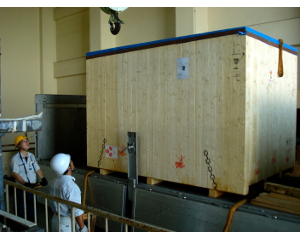
PCMAG arrived at KEK's Fuji experimental hall to be upgraded as a coolant-less superconducting magnet. Image: Toshiaki Tauchi
The superconducting magnet PCMAG came back to KEK on 10 August after four years of use in an experiment at the DESY test beam facility. PCMAG, which stands for persistent-current superconducting magnet, was originally developed as one of the prototype magnets for the BESS (the balloon-borne experiment with a superconducting spectrometer) experiment, a joint US-Japan balloon collaboration between NASA, the University of Denver, the University of Maryland, JAXA, KEK, Kobe University and the University of Tokyo.
The goal of BESS was the search for antiparticle and antimatter of novel primary origins in cosmic radiation, as well as to provide precise measurement of cosmic ray energy spectra. “Currents needed to be in persistent mode for PCMAG because this magnet was designed to be launched to a place where there is no power supply,” said Keisuke Fujii, associate professor at KEK. “Persistent current” means that the magnet, once cooled down to superconducting temperatures, needs to be charged only once, and continues to run without connection to a power supply for some time afterwards.
PCMAG went up into the sky only once for a technical flight at NASA’s Scientific Balloon Flight Facility in New Mexico, US, but never flew into Antarctica’s sky. Instead it was used at KEK’s proton synchrotron (PS) for many experiments, including the development of time projection chambers for linear colliders (LC-TPC).
Since it was designed to be launched into the sky by balloon, it has a special property of a thin-walled and transparent coil, which allows cosmic rays to smash through. It is also convenient for catching the signals from the accelerated particle beam.
“Many scientists from Germany, France, Canada and other countries came to KEK and worked on the LC-TPC R&D at the PS with us,” said Fujii. KEK decided to shut down the PS at the end of the fiscal year 2006. Just at that time a new 21.5-million-euro project had just been approved in Europe. Of the total budget, 7 million euros were contributed by the European Commission. The EUDET project, as it’s called, was designed as a five-year project to build and improve the infrastructure for linear collider detector R&D in Europe. “After discussions between the two laboratories and with the LC-TPC collaboration, KEK loaned PCMAG to DESY for the test with their new beamline in the context of EUDET project.”
KEK sent PCMAG to DESY in 2006. The magnet was installed at the test beam area, delivering a 1.0-tesla magnetic field for LC-TPC prototype studies. The PCMAG was tested and mapped at DESY in 2006 and 2007 under the cooperation of CERN, DESY and KEK.
PCMAG has another unique aspect. To cool the superconducting magnet in the sky, PCMAG was equipped with a 250-litre tank to provide enough liquid helium for a ten-day-long experiment. “This is not a very convenient feature for an experiment on the ground,” says Fujii, since you need to fill the tank every week, a complication you want to avoid if possible.
Fujii explains that PCMAG was returned to KEK “to modify it for operation without liquid helium.” Over recent years, new technologies for superconducting magnets have been developed and have become increasingly popular. These technologies require no coolant, which saves researchers the trouble of frequent replenishing. Instead, compressors mounted close to the magnet provide the needed low temperatures, making the operation much easier and cheaper.
Scientists at KEK have developed the coolant-free superconducting magnet systems for the drift chamber beta-ray analyser experiment (DCBA) to study neutrinoless double beta-decay. By adopting the coolant-less magnet, the performance of two-fold magnetic flux density and eight-fold detection volume has been realised. KEK has a long history of R&D on detectors such as ATLAS, Belle, TOPAZ and VENUS, accumulating know-how on the design of superconducting solenoid coils using indirect cooling methods.
Based on this large body of experience, PCMAG will be upgraded to be a coolant-free magnet. A new system will allow scientists to cool the magnet just by switching it on, freeing them from the difficult, dangerous and expensive operation of preparing and refilling the liquid helium. In addition, the design of the cryostat can be simplified because no dewars or pipes will be needed.
This project is implemented under the agreement on academic exchange signed between DESY and KEK in December last year. It is funded in part by DESY and KEK, and in part by the new European detector development initiative AIDA, which followed the very successful EUDET programme this year.
KEK plans to finish the modification work by next spring and to send the magnet back to DESY. The main customer of the magnet will again be the community of TPC developers, but it will be available to others within the AIDA project as well. PCMAG will stay at DESY for another five years, to be tested at the beamline, dedicated mostly to ILC detector R&D.
“We will publish the detailed baseline document for the ILC detectors by the end of 2012. We would like to start the experiment with the new PCMAG in the next year, we hope in early summer, so that we can include the result into the detailed baseline design,” Fujii said.
PCMAG won’t be a persistent-current magnet anymore. Is it going to have a new name? “PCMAG will stay PCMAG, this time as a unique noun,” said Fujii.

Recent Comments